Water distribution in a private house: design rules + an overview of the best schemes
Laying a pipeline for water supply is a task no less significant than the selection and connection of pumping equipment, the arrangement of a water source. Incorrectly laid out the water supply in a private house can lead to pressure surges, disruption of the system.
To avoid problems, you need to carefully study all the subtleties of the work. We will help you by presenting complete information for studying the specifics of the device systems and assembly rules. The information proposed for consideration is based on regulatory requirements.
The detailed description of the schemes, options, and nuances of the wiring of the water supply circuit that we presented for review is supplemented by visual illustrations and video materials.
The content of the article:
Water distribution schemes
The water distribution can be carried out in two ways - with serial and parallel connection. Choice of water supply scheme depends on the number of residents, periodic or permanent stay in the house or on the intensity of use of tap water.
There is also a mixed type of wiring, in which the faucets are connected to the water supply system through a collector, and the remaining plumbing points and household appliances are connected by the serial connection method.
Scheme # 1. Serial (tee) connection
It is an alternate supply of pipes from a riser or water heater to plumbing devices. First, common pipes are diverted, and then, using tees, they lead branches to places of consumption.
This method of connection is more economical, it requires fewer pipes, fittings, it is easy to install. Pipe wiring with a tee system is more compact, it is easier to hide under finishing materials.
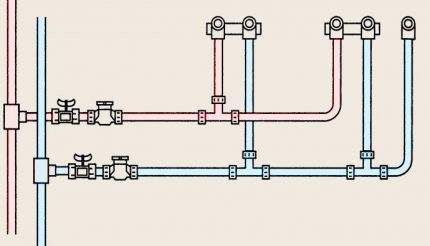
But serial connection more suitable for municipal apartments, for houses with periodic residence or with a small number of residents. It cannot provide uniform pressure in the system when it is used by several users at the same time - at the most remote point the water pressure will change dramatically.
In addition, if you need to repair or connect a plumbing fixture, you will have to disconnect the entire house from the water supply. Therefore, for private houses with high water consumption and permanent residence, it is better to choose a scheme with parallel piping.
Scheme # 2. Parallel (collector) connection
Parallel connection is based on the supply of individual pipes from the main collector to the points of water intake. For cold and hot lines, they install their collector nodes.
This method requires laying a large number of pipes and, accordingly, creates difficulties in masking them. But on the other hand, each point of drawdown will have water pressure, and with the simultaneous use of several plumbing fixtures, changes in water pressure will be insignificant.
A collector is a device with one input for water and several conclusions, the number of which depends on the number of plumbing units, household appliances that use tap water for work.
The collector for cold water is mounted closer to the pipe inlet to the house, and for hot water it is mounted at the outlet of the heater. A purification filter and a pressure regulating pressure reducer are installed in front of the collector.

Water separation
Installation of a hot water supply system and a cold water supply system can be carried out in two ways:
- With a "deaf" wiring. The water supply pipe to the last water intake point ends in a dead end. Such a scheme is more beneficial for saving space from an economic point of view, but it can create inconvenience in the operation of the water supply system. Water will enter the last unit with a delay, and only after it reaches the plug, it will start to flow into the tap.
- With closed circulating wiring. With this method, water constantly moves in a circle, has the same temperature at each point in the system, and arrives at the user immediately after opening the tap. It is advisable to use the peculiarity of this wiring method specifically for a hot water supply system - it is important to prevent sudden temperature jumps in it.
In order not to unnecessarily complicate water distribution in the house, it is more rational to use the combined option. The cold water supply system is performed using a blind wiring, the hot one is circulated.
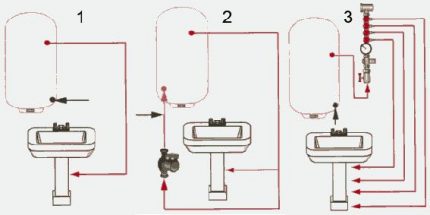
How to make a project yourself?
To properly plan the water supply system, you must first draw up a plan of the house, placing all the plumbing devices in it, equipment that will be connected to the water supply.
All sizes are indicated on a single scale, according to the actual measurements of the premises. The more accurately the plan is drawn up, the more accurately it will be possible to determine the required amount of materials and components.
The water supply scheme should as accurately as possible reflect all the points of water intake, the length and location of pipes for transporting water, and even sewage, as these communications are often carried out nearby. The number of filters, boiler volume, and pumping equipment parameters are also taken into account.
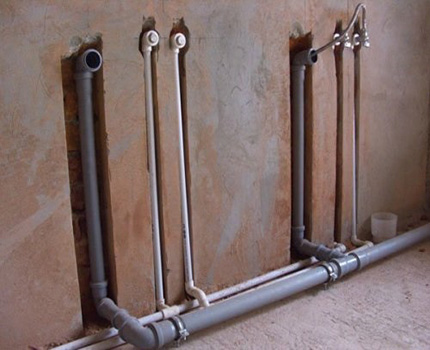
The project must take into account the requirements of construction standards, as well as water supply and sanitation rulesapproved and valid in the country.
Installation of water supply system nodes
A typical wiring diagram of a water system with a well or a well can be used for serial piping.
It consists of the following nodes:
- Pump equipment. For a deep well of more than 8 meters or a well, only a submersible pump is suitable.For shallow sources, assembly stations or surface pumps can be used.
- Transitional nipple. It is necessary for connection with the following elements of the system, which in most cases have a diameter different from the outlet from the pump.
- Check valve. Prevents leakage of water from the system when the pump is idle, water pressure drops.
- Trumpet. Pipes made of polypropylene, steel, metal-plastic or other materials are used. The choice depends on the wiring (external or internal, hidden or open), the price of the material itself, ease of installation. The pipeline supplying water to the house is provided with a heat-insulating layer.
- Water folding fittings. It is used to connect pipes, shut off the water supply, install the pipeline at an angle, etc. It includes: fittings, taps, water sockets, tees, etc.
- Filter group. Designed to protect equipment from ingress of solid and abrasive particles, reduce the iron content in the water and soften it.
- Accumulator tank. It is required to create and maintain a stable pressure of water, to prevent frequent operation of the pump.
- Security group. Needed to control the pressure in the system - pressure switch, pressure gauge and dry run relay. Automatic control devices help maintain a stable pressure in the system and extend the life of the equipment.
All elements of the system are connected in a certain sequence. More details can be considered in the diagram. Further, the installation of the system is described by the example of collector wiring, as more complex.

The collector unit in a private house is installed in special rooms - boiler rooms or boiler rooms - in specially allocated rooms of a residential building, in basement and semi-basement rooms.
In storey buildings, collectors are installed on each floor. In small houses, the system can be placed behind the flush tank in the toilet or hidden in a special cabinet. In order to economize water pipes, the collector is positioned closer to more plumbing fixtures, at approximately the same distance from them.
Installation of the collector assembly, if you follow the direction of the water, is carried out in the following order:
- At the junction of the collector with the main water supply pipe, a shut-off valve is installed to shut off the entire system if necessary.
- Next, a sediment filter is mounted, which delays large mechanical suspensions that can lead to equipment breakdown.
- Then they install another filter, which will remove finer inclusions from the water (depending on the model, particles from 10 to 150 microns).
- The next in the installation diagram is a check valve. It blocks the reverse flow of water when the pressure drops.
After installing the above equipment, a collector is connected to the water supply pipe with so many conclusions that corresponds to the number of water consumption points in the house. If not all plumbing fixtures are connected in the house, then plugs are placed on the unclaimed conclusions of the collector assembly.
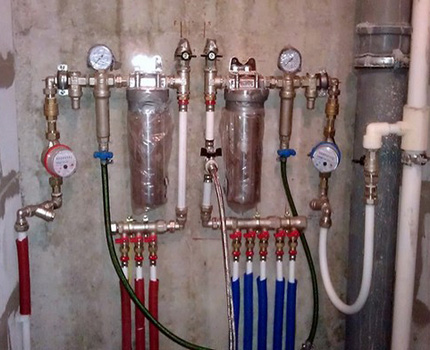
Laying methods - hidden and open system
Pipes in the water supply system can be laid in a closed and open way. The choice of one of the methods does not affect either the quality of the connections or the functionality of the entire system and depends only on personal preferences.
It would seem that it is easy to determine and a closed method is preferable as more aesthetic and allows you to save up to 10 cm of usable space. Why is an open pipeline still used in the installation of a water supply system? Let's try to give an answer.
Hidden wiring allows you to hide pipes and not spoil the aesthetic perception of the interior of the house or apartment. The hidden method is used during assembly water pipes from PP pipes. They hide the contour behind a decorative wall, for example, from drywall, or ditch the walls and pipe the pipes into the formed niches, sealing them with cladding material or plaster on a grid.
The pipeline should not adjoin tightly to surfaces - always leave a small gap for possible repair. When installing the pipeline in a monolith, it is recommended to place them in the casing, inserting the pipe into the pipe.
The disadvantage of the method is manifested when there is a need to repair or replace hidden elements of the system - the plaster or tiling must be opened and then decorated again.
In addition, in the event of damage and leaks, the problem may not be detected immediately and lead first to the loss of operational technical characteristics of the structures, then to flooding of the premises.

To avoid such difficulties, when installing the wiring, only whole sections of the pipe are hidden, placing the fitting in open areas. In places of installation of shutoff valves make inconspicuous doors. This gives service access to pipe connections, which are the weakest links in the system.
It should be noted that pipes not of all materials can be hidden under a layer of plaster - for this, only products made of polypropylene, metal-plastic or copper are suitable.
Open pipe laying is carried out after finishing. The method involves laying bare pipes and water supply elements in no way. It looks ugly, reduces the useful area of the room, but at the same time this method is very convenient for maintenance, repair and dismantling of elements.
Redevelopment and rearrangement of plumbing in the house with such a plumbing arrangement will also not cause difficulties.
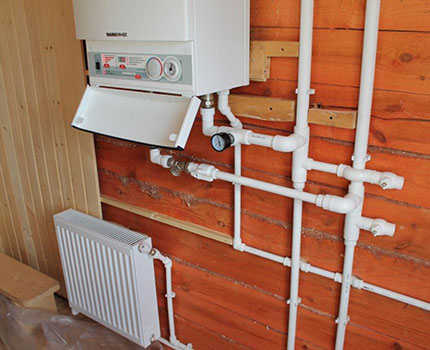
General installation tips
Before mounting the pipeline, it is necessary to install all the fasteners and finish welding work. Pipes that were stored or transported at sub-zero temperatures before laying can withstand at least a day at temperatures above 10 ° C. Before starting the installation, it is necessary to align them and in the future not to allow deflections.

For water risers use pipes with an outer diameter of at least 20 mm, for floor wiring - with a diameter of 16 mm and 14 mm. It is better to use as few collapsible joints as possible. It is necessary that all connecting elements correspond to the type (series) of pipes and, as well as fittings and revisions, are in accessible places.
The horizontal sections of the water supply system should have a bias towards the drainage valves in order to drain the water, the rise is made towards the device through which air will exit when the system is filled with water. When installing vertical structures do not allow their inclination more than 2 mm per meter.
Carrying out vertical installation of the pipeline, hot water pipes are placed to the right of the cold water pipes. With horizontal wiring, cold water pipes are placed below under hot water to prevent condensation.
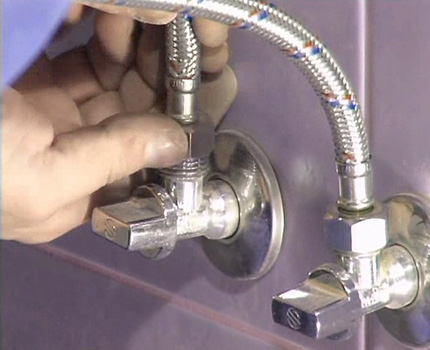
During operation of the hot water supply, a phenomenon such as thermal expansion occurs, which is especially characteristic of polypropylene products. At the same time, the pipes can lengthen, this leads to damage and leaks.
The correct arrangement of fasteners and self-compensation of such sections of the pipeline as bends, turns, gaskets "snake" prevent deformation.
Conclusions and useful video on the topic
Clip # 1. Distribution of the HVS and GVS systems in the two-story house:
Clip # 2. Features of the installation of hot water and cold water in the house:
Clip # 3. How to mount the collector assembly compactly:
You can install the wiring in your own house yourself, but in order to avoid unpleasant consequences from unprofessional work, it is better to ask a specialist to help design the system. Professional advice will help to avoid mistakes, unnecessary expenses and alterations.
Do you have any questions while familiarizing yourself with the material? Do you want to share personal experience or provide interesting information on the topic? Please comment in the block below the text of the article.

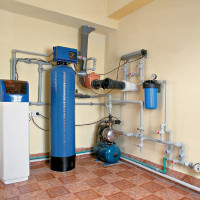 Plumbing in a private country house do-it-yourself: the rules of arrangement
Plumbing in a private country house do-it-yourself: the rules of arrangement 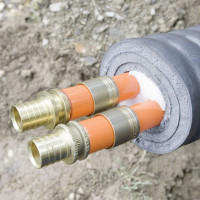 Water supply insulation in the ground: rules for thermal insulation of external branches
Water supply insulation in the ground: rules for thermal insulation of external branches 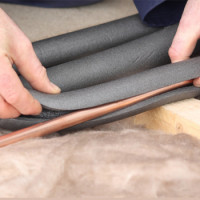 Insulation for water pipes: the choice and methods of laying thermal insulation of water pipes
Insulation for water pipes: the choice and methods of laying thermal insulation of water pipes 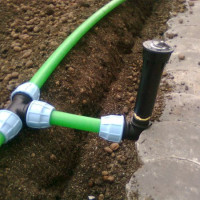 How to organize a summer water supply in a country house: laying and arranging a water supply for irrigation
How to organize a summer water supply in a country house: laying and arranging a water supply for irrigation 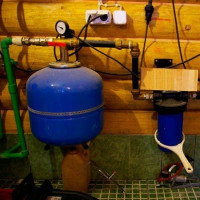 How to make a water pipe in the country with your own hands: rules for laying, installing and arranging
How to make a water pipe in the country with your own hands: rules for laying, installing and arranging 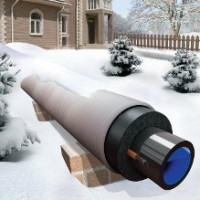 Water supply heating: the best heating options + analysis of technical features
Water supply heating: the best heating options + analysis of technical features  How much does it cost to connect gas to a private house: the price of organizing gas supply
How much does it cost to connect gas to a private house: the price of organizing gas supply  The best washing machines with dryer: model rating and customer tips
The best washing machines with dryer: model rating and customer tips  What is the color temperature of light and the nuances of choosing the temperature of the lamps to suit your needs
What is the color temperature of light and the nuances of choosing the temperature of the lamps to suit your needs  Replacement of a geyser in an apartment: replacement paperwork + basic norms and requirements
Replacement of a geyser in an apartment: replacement paperwork + basic norms and requirements
Recently, repairs were made in one private house, and there was a consistent circuit, but such that the guard. Apparently, the owner of the house decided to save money and hired some students. I had to do everything anew. If we talk on the topic - it’s better not to draw up a diagram yourself, then you won’t get any problems. Even when I was building in my house, I chose contractors so as not to mess things up.
I did everything for a summer residence. We have a well of 12 meters, and a small two-story house. The scheme is consistent, of course. There were no problems with this at all. But the pipes ... On the terrace in the first winter they burst, although I drained all the water. Now you have to put the heating for the whole winter at +5, although we only come on weekends. I'm already tired that neither winter: either the pump will fly, or the pipes can’t stand it. Or my hands are so crooked, or the equipment is dubious.